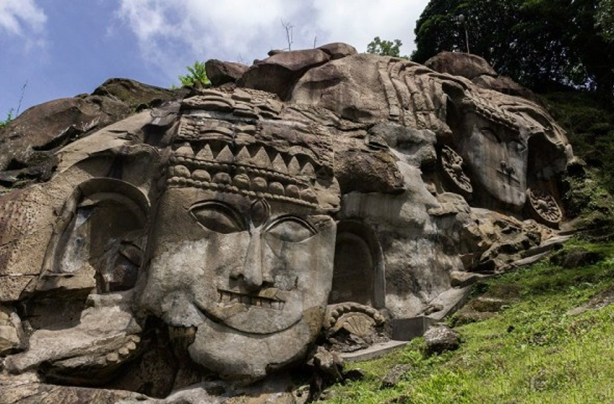The Indian state of Tripura is a less explored rather a hidden gem of a tourist site.
The Indian state of Tripura is a less explored rather a hidden gem of a tourist site.
Now when travel blogging, ‘YouTube’ing are very popular among youth, these hidden gems are being explored and their stories have started to reach every travel enthusiast.
India is a land full of mystery. Tripura too holds too many secret in her lap.
Tripura literally meaning ‘Three Cities’, perhaps it is save to assume it has got its name from Tripura Sundari, the presiding devi of the region. It is the third smallest Indian state.
A mysterious tourist attraction which lies amidst the thick forested Jampui Hills of north Tripura is a place ‘Unakoti’. It is Bound by the Manu River and the region is home to one of the most spectacular heritage sites in South Asia- ‘the giant bas-relief sculptures’ of Unakoti.
Bas-relief or low relief is a type of sculpture in which an image is projected at a shallow depth. This technique is often used in the art of ancient Egypt and other Near Eastern cultures. One of the largest bas-relief sculptures in the country can be found at Unakoti.
Located around 178 km from Agartala, the state capital, Unakoti’s ‘Lost Hill of Faces’ is a centuries-old pilgrimage spot dedicated to lord Shiva, the travel bloggers have even named it India’s version of Macchu Picchu.
Unakoti means ‘one less than crore’. The gigantic sculptures of Hindu gods have been chiselled out of the hill. and they are dated back to 8th and 9th centuries. Most of them are about 30 to 40 feet high and have a edge of rawness of the tribal style of art.
The most famous one of them is the Unakotishwara Kal Bhairav, a 30-foot high carving of Shiva’s head. Its most eye-catching feature is its 10-foot high intricate headdress that is adorned by a warrior-like Goddess Durga on one side and Goddess Ganga on the other.
Besides these, there are several other sculptures including Ganesh, Hanuman, and Nandi.
The mysterious part is the creators of these sculptures are unknown even today. And they have not been attributed to any dynasty that ruled Tripura. We can only find legends and fables.
Rajamala, the official history of the Manikya kings of Tripura has one such story.
Mahadeva Shiva was travelling to Kashi. There were other gods who were accompanying Shiva. Including Shiva, number of gods was one crore.
When the deities arrived at this spot, they decided to rest and travel again in the morning. Before going to sleep, Shiva had instructed his entourage to wake up at sunrise so as to continue their long journey.
But When dawn broke the next day, however, only Shiva was awake, the rest of the gods were still fast asleep.
This angered Shiva and he cursed them to turn into stones, and continued his journey to Kashi on his own.
Hence the place got the name Unakoti- one crore gods except Shiva, one less to crore.
Another legend says, these rock-cut reliefs were carved by a talented sculptor called Kalu Kumhar, who was a great devotee of Shiva-Parvati.
When the Shiva Parvathi were on the way to Kashi with other gods, they passed through this region. Kalu Kumhar approached them and asked for permission to accompany them to Kashi.
But Shiva knew that Kalu Kumhar has yet to achieve spiritual knowledge which could take him near to the gods. Parvathi came up with a solution which would not hurt Kalu Kumhar’s feelings, which in turn will make him understand his short comings.
He was asked to carve sculptures of all one crore God by morning to be able to accompany them to Kashi.
When dawn broke, kalu kumhar fell short by one sculpture and he was left behind.
Due to the presence of the images of Shiva and Durga, one of the major Hindu festivals celebrated at Unakoti is the Ashokastami festival. This festival, which takes place between March and April each year, celebrates the victory of Rama over the evil king of Lanka, Ravana.
According to the folklore based on Ramayana , Rama was unable to slay Ravana, as he was protected by the goddess Kali. In order to gain allaigence of Kali, Rama was advised to worship the goddess. Once Kali was on the side of Rama, he was able to slay Ravana. The legend tells that in celebration of his victory, Rama took Shiva and Durga (Kali) for a ride on his chariot. The Ashokastami festival is celebration of this victory.
Although Unakoti is a well-known pilgrimage site for Hindus, there is much more to learn about the site and its reliefs. Apart from the lack of information regarding the age of the reliefs and the people who made them, it is also unclear as to the total number of reliefs.
According to an assessment made by the Archaeological Survey of India, it seems that there are still reliefs and statues in the jungle yet to be discovered. Perhaps one of these undiscovered objects may provide with more information about these works of art.
It has also been speculated that Unakoti might be added into the list of UNESCO’s World Heritage Sites. Perhaps this would help researchers to find new information about Unakoti and its magnificent bas-reliefs.
Dr Sindhu Prashanth


